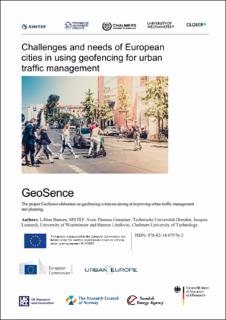| dc.description.abstract | This report presents the results and analysis of exploratory interviews and a questionnaire survey among transport experts and professionals in Europe dealing with geofencing in urban transport management. As part of the European collaboration project GeoSence - "Geofencing strategies for implementation in urban traffic management and planning", the report contributes to a first step of solving the problems by identifying and exploring the challenges and needs of transport authorities. Starting from the cities' biggest traffic challenges, as experienced by municipalities and cities, but also from the perspective of regional and national authorities, the report focuses mainly on geofencing and its following unresolved implementation issues, such as lack of regulation, an issue prevalent across both experienced and less experienced users of geofencing, GNSS accuracy and infrastructure, user acceptance, costs, knowledge and various practicalities. In the discussion section we synthesise how to overcome some of the barriers and how to tackle those needs suggested by the informants, as well as presenting risks and possible mitigation options, and a transferability analysis for cities that do not use geofencing yet. While findings show the applications of geofencing for micro-mobility and parking as the most transferable use case, the case also is an example of how regulation and the legal framework would need to keep pace with the development of the practical solutions. In conclusion, several recommendations are derived, including the need for investing in digital infrastructure in European cities, and further developments matching digital and physical infrastructure to achieve the potential for geofencing. Further, increasing municipalities capacity for knowledge building- and sharing, starting new geofencing real traffic trials, as well as scaling up and transferring existing and good functioning solutions will be key. | en_US |
